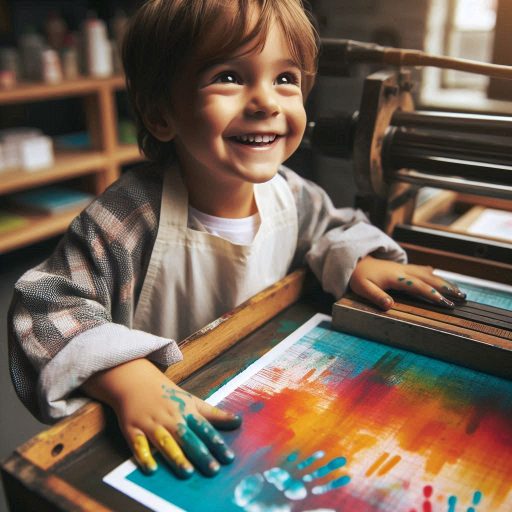Introduction
Aquatint and mezzotint are two important intaglio printmaking techniques that produce stunning tonal effects.
Each method uses unique processes to achieve remarkable depth and texture in prints.
Aquatint is a technique that allows artists to create soft, shaded areas in prints.
It uses acid to etch the metal plate, with resin powder controlling the depth of tone.
This process results in prints with subtle gradations of tone, ideal for achieving watercolor-like effects.
Mezzotint, on the other hand, is known for its ability to produce rich, velvety blacks.
Artists roughen the plate with a tool called a rocker and then smooth areas to create lighter tones.
This results in dramatic contrasts between dark and light, perfect for creating bold images.
Aquatint and mezzotint play significant roles in the evolution of printmaking.
Aquatint, favored by artists like Francisco Goya, allowed them to mimic the effect of ink washes or watercolor paintings.
It expanded the creative possibilities of printmaking, especially in the realm of fine art.
Mezzotint, preferred by portrait artists in the 18th century, became renowned for its ability to render lifelike detail and depth.
This technique made it possible to achieve intricate gradations in light and shadow, contributing to its popularity in reproducing oil paintings.
Both techniques remain vital for artists today, offering endless possibilities for expression.
Their contribution to the art world highlights their importance in producing unique and beautiful works.
Aquatint Technique
The process of creating an Aquatint print
Aquatint is a printmaking technique used to create tonal effects in an etched image.
The process involves covering a metal plate with powdered resin, which is heated to adhere to the plate.
The artist then immerses the plate in acid, which etches areas between the resin grains.
The longer the plate stays in the acid, the darker the tonal value becomes.
This method allows artists to produce rich, subtle gradients and detailed shading in their prints.
Transform Your Career Today
Unlock a personalized career strategy that drives real results. Get tailored advice and a roadmap designed just for you.
Start NowMaterials needed for the Aquatint process (e.g. powdered resin, etching needles)
To create an aquatint print, you need a variety of materials.
First, powdered resin is essential for creating the textured surface.
A metal plate, usually copper or zinc, serves as the canvas for the etching.
Etching needles are used to expose the metal plate by removing the resin, creating different tonal areas.
Other necessary tools include brushes for applying resin, acid baths for etching the plate, and a printing press to transfer the image onto paper.
Examples of famous artworks created using Aquatint
Many famous artists have created masterpieces using aquatint.
One notable example is Francisco Goya, who used aquatint in his series Los Caprichos.
These prints are known for their rich tonal contrast and eerie, dreamlike quality.
Another example is Edgar Degas, who employed aquatint to enhance his portraits and ballet scenes with delicate shadows and depth.
These artworks demonstrate the unique ability of aquatint to convey mood through tone rather than line alone.
In summary, the aquatint technique allows artists to produce tonal images with remarkable depth and texture.
With the right materials and skill, this process creates beautiful prints that stand the test of time.
Read: Art and Design: Printmaking Specializations
Mezzotint Technique
The Process of Creating a Mezzotint Print
Mezzotint is a printmaking technique that uses a unique method of creating tonal gradation.
Artists first roughen the entire surface of a metal plate using a rocker tool.
This creates a rough texture that holds ink, producing a rich black when printed.
To create an image, the artist smooths areas of the plate with a burnisher or scraper.
The more the plate is smoothed, the lighter the resulting areas become, allowing for subtle tonal shifts.
The result is a print with soft transitions between dark and light areas.
How the Mezzotint Technique Differs from Other Printmaking Techniques
Mezzotint stands out because of its ability to create velvety blacks and smooth tonal gradients.
Transform Your Career Today
Unlock a personalized career strategy that drives real results. Get tailored advice and a roadmap designed just for you.
Start NowUnlike etching or engraving, where lines define the image, mezzotint relies on texture to control the ink’s retention.
This technique allows for soft, painterly effects, unlike the stark contrasts of other printmaking methods.
Mezzotint also avoids the need for chemical processes like those used in aquatint or etching.
Its tonal capabilities make it a preferred technique for capturing delicate shadows and dramatic light contrasts.
Notable Artists Known for Using Mezzotint in Their Work
Several artists have mastered mezzotint, pushing its expressive potential.
John Martin, a 19th-century British artist, used mezzotint to create his dramatic, atmospheric landscapes.
More recently, American artist Carol Wax is renowned for her mezzotints, often depicting everyday objects with rich textures and light effects.
These artists, among others, demonstrate mezzotint’s power to convey emotion through light and shadow, leaving a lasting impact on the printmaking world.
Mezzotint remains a distinctive and captivating printmaking technique, favored by artists for its depth and tonal richness.
Read: Printmaking Workshops and Classes Near You
History of Aquatint and Mezzotint
Aquatint and mezzotint, both intaglio printmaking techniques, revolutionized the art world by offering unique tonal effects.
Their histories are rich, tracing back to centuries of experimentation and artistic growth.
Origins of Aquatint in 18th-Century Europe
Aquatint emerged in the 18th century in Europe as a method to achieve tonal shading in prints.
Its invention is credited to Jean-Baptiste Le Prince, a French artist, around 1768.
He developed aquatint to mimic the look of watercolor paintings in printed form.
This method quickly gained popularity due to its ability to create soft, atmospheric effects.
It allowed artists to produce prints with a wide range of gray tones, enhancing depth and texture.
Evolution of Mezzotint from the 17th Century to Present Day
Mezzotint, developed earlier in the 17th century, is known for its rich, velvety blacks and smooth tonal transitions.
Ludwig von Siegen, a German soldier and amateur artist, invented mezzotint in the 1640s.
The process involves roughening the surface of a metal plate to create a uniform dark tone, then smoothing areas to achieve lighter shades.
Transform Your Career Today
Unlock a personalized career strategy that drives real results. Get tailored advice and a roadmap designed just for you.
Start NowOver the centuries, mezzotint evolved, becoming a favored technique for portraiture and reproducing paintings.
Although its popularity declined with the advent of photography, mezzotint continues to be used by contemporary artists for its distinctive qualities.
Influence of Aquatint and Mezzotint on the Art World
Both techniques had a profound impact on the art world.
Aquatint allowed for the reproduction of paintings and illustrations with greater tonal subtlety.
Mezzotint, with its deep contrasts, became synonymous with fine art portraiture.
Together, they expanded the expressive range of printmaking, influencing generations of artists and printmakers.
Even today, aquatint and mezzotint hold an important place in contemporary printmaking practices, continuing to inspire new artistic innovations.
Read: The Evolution of Printmaking Over Time

Advantages of Aquatint and Mezzotint
Ability to create tonal variations and rich textures in prints
Aquatint and mezzotint techniques allow artists to achieve a wide range of tones, from light to dark.
These methods enable artists to create intricate textures that add depth and dimension to their prints.
By using aquatint and mezzotint, artists can add subtle gradations of color and shading to enhance their prints.
Versatility in creating different effects and moods
Aquatint and mezzotint offer flexibility in terms of creating various visual effects and emotional tones.
Artists can use these techniques to convey different moods, from serene to dramatic, in their artworks.
The versatility of aquatint and mezzotint allows artists to experiment with different styles and themes.
Impact of these techniques on the overall aesthetic of artworks
Aquatint and mezzotint techniques can significantly enhance the overall aesthetic appeal of artworks.
The rich textures and tonal variations created through these methods add visual interest to prints.
Using aquatint and mezzotint can elevate the quality of an artwork and make it stand out to viewers.
In short, aquatint and mezzotint techniques offer artists a unique way to create prints with rich textures, tonal variations, and versatile effects.
These methods can have a significant impact on the overall aesthetic of artworks, making them visually compelling and engaging for viewers.
Artists who utilize aquatint and mezzotint in their work can explore a wide range of creative possibilities and enhance the depth and complexity of their prints.
Transform Your Career Today
Unlock a personalized career strategy that drives real results. Get tailored advice and a roadmap designed just for you.
Start NowRead: Exploring Different Printmaking Techniques
Challenges and Techniques in Aquatint and Mezzotint
Difficulties in mastering these complex printmaking techniques
Mastering aquatint and mezzotint requires significant skill and practice.
Both techniques present unique challenges for printmakers.
Aquatint involves controlling acid application to create tonal variations, while mezzotint requires meticulous smoothing and roughening of the plate.
These processes demand patience and precision, which can frustrate beginners.
Tips for achieving desired results in Aquatint and Mezzotint prints
To achieve the best results in aquatint, it’s crucial to control the acid exposure.
Varying the acid’s strength and timing creates different tonal values.
Artists must also protect areas of the plate using resin or stop-out varnish.
Proper planning and execution will yield smooth gradients and detailed shadows.
In mezzotint, using a rocker tool correctly is essential for building rich tones.
Artists must ensure consistent pressure to avoid uneven texture.
It’s also vital to scrape and burnish the plate strategically, as these steps add depth and detail to the artwork.
Common mistakes to avoid when working with Aquatint and Mezzotint
Common mistakes in aquatint and mezzotint can ruin prints.
In aquatint, improper acid exposure often results in overly light or dark tones.
Failing to protect areas from acid can lead to unintended marks or damage.
In mezzotint, uneven rocking can cause an irregular tonal surface, which distorts the final image.
Beginners often struggle with scraping and burnishing, leading to harsh transitions instead of smooth tonal shifts.
Overcoming these challenges requires practice and a deep understanding of each step in the process.
With patience and attention to detail, artists can create prints that display beautiful depth, texture, and tonal range in both aquatint and mezzotint.
Contemporary Uses of Aquatint and Mezzotint
Modern artists are finding unique ways to incorporate Aquatint and Mezzotint techniques into their work.
Transform Your Career Today
Unlock a personalized career strategy that drives real results. Get tailored advice and a roadmap designed just for you.
Start NowThese traditional printmaking methods have stood the test of time and continue to inspire contemporary artists in new and innovative ways.
How modern artists are incorporating Aquatint and Mezzotint techniques in their work
Contemporary artists are experimenting with new approaches to Aquatint and Mezzotint, pushing the boundaries of these traditional techniques.
Some artists are combining them with digital technologies to create hybrid prints that blend the old with the new.
For example, artists may use computer-assisted tools to enhance the textures and tones achieved through Aquatint and Mezzotint, adding a layer of complexity to their prints.
This merging of traditional and digital methods results in unique and visually stunning artworks that appeal to a modern audience.
Additionally, artists are exploring the possibilities of scale and presentation with Aquatint and Mezzotint prints.
Large-scale installations, where prints are displayed in unconventional ways, create a dynamic and immersive experience for viewers.
By thinking outside the traditional frame, artists can engage with audiences in new and unexpected ways.
Influence of technology on the traditional methods of Aquatint and Mezzotint
While technology has influenced all aspects of contemporary art, it has also impacted the traditional methods of Aquatint and Mezzotint.
Artists now have access to digital tools that can streamline the printmaking process, allowing for greater efficiency and precision.
For example, artists can use software programs to create intricate textures and patterns that would be challenging to achieve by hand.
This digital assistance opens up new possibilities for experimentation and innovation in the realm of Aquatint and Mezzotint printmaking.
However, some artists choose to maintain the authenticity of traditional methods, embracing the time-consuming and labor-intensive process as part of the art form’s intrinsic value.
By balancing digital technologies with handcrafted techniques, artists can preserve the rich history of Aquatint and Mezzotint while also exploring contemporary expressions.
Exhibition showcases featuring Aquatint and Mezzotint prints
Art galleries and museums around the world are recognizing the enduring appeal of Aquatint and Mezzotint prints by hosting dedicated exhibition showcases.
These exhibitions provide a platform for artists to display their works and for audiences to appreciate the intricacies of these printmaking techniques.
Curated shows often highlight the diverse approaches and styles of artists working with Aquatint and Mezzotint, showcasing the versatility of these methods in creating captivating and visually engaging prints.
By bringing together a collection of prints, exhibitions invite viewers to explore the nuances and complexities of printmaking as an art form.
Furthermore, these showcases serve as educational tools, introducing audiences to the history and process of Aquatint and Mezzotint.
Through workshops, artist talks, and interactive displays, viewers can gain a deeper understanding of the techniques involved in creating these prints, fostering an appreciation for the craftsmanship and skill required in printmaking.
Transform Your Career Today
Unlock a personalized career strategy that drives real results. Get tailored advice and a roadmap designed just for you.
Start NowIn a nutshell, the contemporary uses of Aquatint and Mezzotint continue to evolve as artists experiment with new techniques and technologies.
Whether blending traditional methods with digital tools or exploring innovative approaches to scale and presentation, artists are finding ways to breathe new life into these age-old printmaking techniques.
Exhibition showcases further highlight the enduring appeal of Aquatint and Mezzotint, offering audiences a glimpse into the rich history and intricate process behind these unique art forms.
By embracing both tradition and innovation, artists are keeping the legacy of Aquatint and Mezzotint alive and inspiring future generations to explore the endless possibilities of printmaking.
Comparison between Aquatint and Mezzotint
Differences in the application and results of Aquatint and Mezzotint
Aquatint and Mezzotint are two distinct printmaking techniques that produce different visual effects.
Both methods offer unique textures and tonal ranges, allowing artists to convey various emotions and styles.
Aquatint involves using resin to create tonal effects on a metal plate.
The plate is then etched in acid, producing areas of varying shades, depending on the exposure time.
The final result mimics the appearance of watercolor washes.
Mezzotint, on the other hand, uses a tool called a rocker to roughen the entire plate.
Artists gradually burnish areas to create lighter tones, resulting in rich, velvety blacks and smooth transitions between tones.
How artists choose between these two techniques based on their artistic vision
Artists choose between Aquatint and Mezzotint based on their artistic goals.
Aquatint is ideal for those seeking a lighter, more painterly effect with a wide range of gray tones.
It excels in creating soft textures and is often used for landscapes or atmospheric compositions.
Mezzotint, with its deep contrasts and sharp gradations, is preferred when an artist wants to emphasize drama, depth, and bold imagery.
The decision largely depends on the intended mood and the desired finish.
Examples of artworks that showcase the unique characteristics of Aquatint and Mezzotint
Examples of artworks highlighting Aquatint include Francisco Goya’s “Los Caprichos” series, known for its subtle tonal ranges.
Mezzotint’s characteristics can be seen in works by John Martin, whose prints exhibit striking contrast and detailed textures.
These techniques continue to inspire modern artists, who experiment with both for their distinct qualities.
All in all, while Aquatint and Mezzotint differ in application and outcome, both offer unique creative possibilities.
Transform Your Career Today
Unlock a personalized career strategy that drives real results. Get tailored advice and a roadmap designed just for you.
Start NowArtists select the technique that aligns with their vision, producing prints that reflect their mastery of tone and texture.
Conclusion
Aquatint and mezzotint are both celebrated for their unique ability to produce rich tonal variations.
Aquatint allows artists to create images with delicate gradations, similar to watercolor paintings.
Mezzotint, on the other hand, is known for its deep, velvety blacks and smooth transitions between light and shadow.
Both techniques hold a prominent place in the history of printmaking, enabling artists to push creative boundaries.
Artists are encouraged to explore these printmaking techniques to expand their artistic skills.
Aquatint offers a wide range of tonal control, allowing for expressive depth in prints.
Mezzotint, with its labor-intensive process, yields strikingly bold contrasts, rewarding artists with visually impactful results.
These techniques offer new opportunities for experimentation and creativity within their art practice.
Aquatint and mezzotint remain relevant in today’s art world, influencing modern artists.
Their ability to create depth and texture makes them adaptable to contemporary styles.
Many artists still use these methods to produce works that resonate with today’s audiences.
The traditional yet versatile nature of these techniques continues to captivate both creators and collectors.
In the end, the significance of aquatint and mezzotint in printmaking endures.
Artists can gain inspiration by incorporating these timeless techniques into their work.
Aquatint’s subtle gradations and mezzotint’s bold contrasts bring new dimensions to artistic expression.
These techniques offer endless possibilities, making them a relevant choice in contemporary art trends.
Their ability to capture light, shadow, and texture ensures they will remain a staple in printmaking for years to come.




